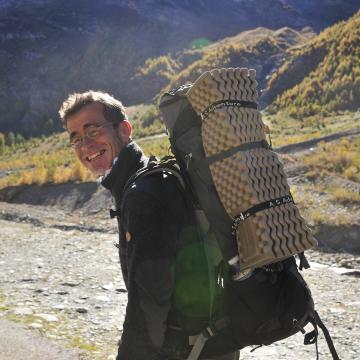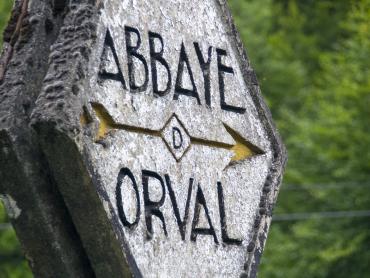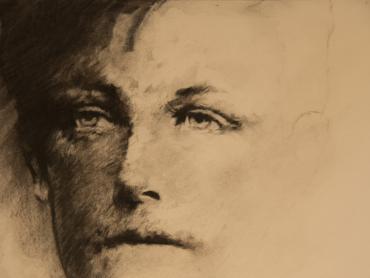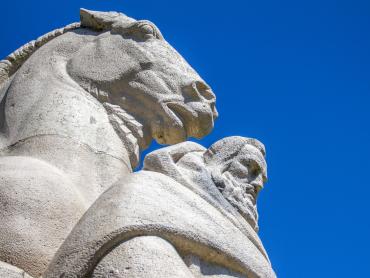
Pierre Pauquay
Member for 5 years 4 months
The Ardennes in all directions
Culture and Hiking
Following in the footsteps of Arthur Rimbaud
Arthur Rimbaud, the rebellious poet of the Ardennes
5 mins OF POETRY
From Charleville-Mézières to Bohan, via the Meuse and Semoy valleys, I retrace the footsteps and works of Rimbaud, a 19th-century genius and the Mozart of poetry.
Many a poet has taken, or still takes, inspiration from the mist-draped rivers and never-ending forests of the Ardennes. This land was explored by a local enfant terrible, Arthur Rimbaud, a poet who was every bit as rebellious and disobedient as the Ardennes countryside. This young man from Charleville-Mézières wrote his first poem at the age of 15. Six years later, his ink ran dry forever. The life of this shooting star was short, but his universal memory is still very much alive.
An undying legend
I wander through the streets of Charleville-Mézières, and sit at a café terrace on Place Ducale to admire the golden façades gleaming in the sun, contrasting with the cool shade of these arches. I can feel the poet's presence in this town where he was born, on 20 October 1854. From Place Ducale, I walk down Rue du Moulin to the Old Mill, now the Rimbaud Museum. It is home to a remarkable collection of works by the likes of Picasso, Cocteau and Fernand Léger, all devoted to Rimbaud. One of the rooms exhibits the poet's personal belongings and the huge trunk that accompanied him to the four corners of the world - the Dutch Indies, Jakarta, and Ethiopia. Across the street, the "Maison des Ailleurs" pays tribute to the glory of Rimbaud. The lighting effects of this memorial site take me following the artist on his wonderful travels. But his appetite for faraway places was to lead him to his death. He contracted an infection and returned to Marseilles with pus weeping from an amputated stump. He died on 10 November 1891 and was buried near his family. I'm moved by his grave at Charleville-Mézières cemetery, and the letterbox that's still bursting with letters written by poetry fans. A legend never dies...
Fleeing to faraway places
In the Ardennes, I prepare to follow in Rimbaud's footsteps to discover the places where he went to find escape, revitalisation and inspiration. During his short life, this little rascal with the face of an angel had just one ambition, to run away from home. At the end of the 19th century, progress arrived in the countryside of France in the form of the railway, providing an escape route for the boy from Charleville... At the age of fifteen, Rimbaud jumped on a train and fled his hometown, as well as the Prussian occupation and his mother's control. I cycle to the station and take a train to Givet, taking my bike with me. This way I'll be able to travel faster than the poet with the wind in his heels.
In 1863, the railway line crossed the steep Meuse valley on the same enormous viaducts that it still takes today. I decide to alight at Monthermé and continue by bike along the beautiful cyle path that follows the River Semoy. This authentic region sitting between two countries was an inspiration to Rimbaud, who came here to recharge his batteries. Most of the valley is steep but, between Tournavaux and Haulmé, it opens up into a vast alluvial plain. The atmosphere here is unique with the landscape draped in mist. I follow the Cassis River, named after one of his poems... then continue along the Semoy, feasting my eyes on the scenery before reaching the village of Hautes-Rivières.
Misery Valley
In Rimbaud's day, the Semoy valley certainly didn't attract tourists. To survive here, people turned to smuggling or making nails. To the poet, this place was "Misery Valley". The cycle path ends at Hautes-Rivières, but I continue all the same to Belgium, where the River Semoy becomes the River Semoi. On the other side of the border, Rimbaud is in heaven.
In Bohan, my wheels are hot on the heels of the French fraudster who took the secret paths of the Baraques valley into the depths of the forest where, on Belgian territory, tobacco and coffee were traded at much lower prices. In the village, I meet Jacques who tells me how, as a child, he used to fill his pockets with Côte d'Or chocolate for his French friend who he would meet in the woods...
Bewitching landscapes that influenced the work of one of the greatest poets of all time.
I'm looking forward to returning to the Meuse valley. I turn back and head for Monthermé, then continue to Givet... The Meuse crosses the Ardennes 300 metres below the highest summit of this very steep valley that's almost a canyon. The forest-covered hillsides plunge into the valley on either side. I enter this harsh landscape where the Industrial Revolution unfolded at places like Revin and Fumay. Located in the heart of this valley of iron and timber, the town is linked forever with the metal industry, which has left an impact on the landscape. When Rimbaud stopped here on his way to Belgium, he observed in disbelief the distress of men, women and children who were exhausted from labouring in the foundries.
I cycle effortlessly towards Fumay on this magnificent cycle path. Rimbaud witnessed the tumult of this town. At the port, barges were loaded with heavy slabs of schiste extracted from the bowels of the surrounding mountains. Slate used to be shipped to every corner of the world from this riverport which is now a pleasant marina. This isn't the Ardennes region that Rimbaud knew. People smile here now, and get to explore one of the most beautiful cycle paths in Europe... In Givet, I leave Arthur Rimbaud's road to Charleroi and his fate. I catch the train back to Charleville-Mézières, where my short journey comes to an end as I cross the bewitching landscapes that influenced the work of one of the greatest poets of all time.
Try this experience
24 Place Ducale
08000 CHARLEVILLE-MEZIERES, FRANCE
Tel: +33 (0) 3 24 56 06 08





















I retrace the footsteps and works of Rimbaud, a 19th-century genius and the Mozart of poetry